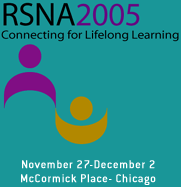
Abstract Archives of the RSNA, 2005
Zhengrong Zhou MD, Presenter: Nothing to Disclose
Hongshi Wang MD, Abstract Co-Author: Nothing to Disclose
Zheng Dong MD, Abstract Co-Author: Nothing to Disclose
Weijun Peng MD, Abstract Co-Author: Nothing to Disclose
To investigate the value of MRI in the diagnosis of schwannomas of the brachial plexus correlated with the surgical findings.
36 patients with schwannomas of the brachial plexus, proven surgically and pathologically, referred for MR imaging with a 1.5-T unit. All patients underwent axial T2-weighted imaging, pre- and post-contrast T1-weighted axial, oblique sagittal and coronal imaging covering the axilla to the middle of the neck. The MRI findings were evaluated independently by two radiologists for the locations of masses, size, margin, signal intensity, contrast enhancement, and extent of the lesions. The locations and characteristics of the lesions on different types of MR sequences were described with surgical and pathologic correlation.
All patients had large schwannomas (mean 4.9 cm in diameter) presenting as a mass along a brachial plexus nerve root, explored by MRI. The MRI findings were in agreement with the final diagnosis in all the cases. Most of the masses (n=30) exhibited spindle or longish shape with well-defined margins.16 cases appeared as homogeneous hypo- or isointense to muscle in T1-, hyperintense in T2-weighted images, and moderate contrast enhancement after administration of contrast media. 20 lesions were hypo-isointense to muscle on T1-weighted images and heterogeneous hyperintense on T2-weighted images which had central areas with low signal intensity, the so-called target sign, and enhanceed intensely after administration of gadolinium-based contrast material. All patients had been operated upon using microsurgical technique: enucleation of the tumor content, piecemal removal of the capsule, identification and preservation of the neural elements were the main goals of the operation in all cases.
The locations, morphologic features and MR signal characteristics are useful in detecting schwannomas of the brachial plexus and can help improve ability in differentiating diagnosis and evaluating prognosis. The microsurgical treatment with preservation of the neural structures, as for schwannomas of the cranial and spinal nerves, results in good outcome without recurrences.
Zhou, Z,
Wang, H,
Dong, Z,
Peng, W,
MRI Features of Schwannomas of the Brachial Plexus Correlated with the Surgical Findings. Radiological Society of North America 2005 Scientific Assembly and Annual Meeting, November 27 - December 2, 2005 ,Chicago IL.
http://archive.rsna.org/2005/4419663.html

